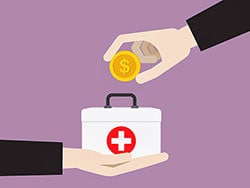It’s not uncommon for doctors to meet with pharmaceutical and medical device representatives at some point in their careers. However, a new study published in JAMA Network Open examines how frequently residents engage with these companies and if faculty and training environments increase the odds.

Using data from the Open Payments Program (OPP), investigators from the Johns Hopkins School of Medicine and the Accreditation Council for Graduate Medical Education (ACGME) reviewed general payments — such as meals, gifts, and travel — made to residents during one academic year beginning July 1, 2020.
Of 124,715 residents, 12% received payments valued at $6.4 million during the year. About $4 million went to primary care (internal medicine, family medicine, or ob/gyn) and surgical specialty (general surgery, orthopedic surgery, or urology) residents. Still, only 13% of those trainees accepted payments.
Despite some residents receiving upwards of $50,000 in grant funding, the median resident payment was valued at $64.40, and about 90% of that went toward food and drink, often supplied in group settings, the study showed.
Almost 40% of residency program directors (PD) received payments exceeding $5 million, potentially “creating a social environment that condones acceptance of industry payments,” say the authors. However, the study indicated that residents with a PD who accepted payments were only 1% more likely to do so themselves. The median value of a PD payment was $119.55.
Although the researchers did not explore how industry payments affect residents’ decision-making, the findings serve as a reminder that sponsoring institutions should “be in substantial compliance” with ACGME’s institutional requirements, including having a policy that addresses vendor interactions with residents and fellows, the study’s lead author, Sean O. Hogan, PhD, director of outcomes research and evaluation at ACGME, told Medscape Medical News.
Keith Horvath, MD, senior director of clinical transformation in healthcare affairs at the Association of American Medical Colleges, reviewed the study and questioned the validity of the data.
“There were actually no payments directly to residents but saying ‘industry buys lunch for residents’ isn’t as catchy,” he said.
Horvath told Medscape that sales representatives are incentivized to count everyone who walks into the room — including residents, faculty, and nurses — regardless of meaningful engagement. And because reporting of industry payments to residents is voluntary, not audited or otherwise vetted, he says the OPP figures are probably inaccurate.
“It’s a poorly spun approach to claim that having a sales rep somewhere near you will influence your decision,” he said.
The study’s authors make note of the voluntary reporting to say that the extent of resident industry payments might be underrepresented. They suggest that since nearly all active residents now have a national provider identification (NPI) number, including residents in OPP data could clarify how financial relationships established during the formative years of medical training influence patient care.
Payments Vary by Specialty and Institution Type
In the study, ob/gyn residents received the lowest total payments. The most payments, about $2.2 million, went to orthopedic surgery residents, who were 3.2 times more likely to receive payments than internal medicine residents. The findings are similar to a study last year by the same research team that found that surgeons collected the most money from industry.
This is not surprising, says Horvath. “Any specialty that involves a device, which is constantly tweaked and updated, requires some education for the providers and entire team to understand how to use it,” he said. These discussions frequently occur at sponsored lunches, allowing physicians to see if an updated device will still work for their patients.
Besides specialty, the study found that payments varied by gender and sponsoring institution. Male residents were more frequent recipients of general payments than women and those who were nonbinary or did not specify a gender. Residents affiliated with for-profit institutions were 3.5 times more likely to accept industry payments than residents in federal institutions. In contrast, those in nonprofit organizations were twice as likely to do so than those in government-sponsored facilities.
Steph Weber is a Midwest-based freelance journalist specializing in healthcare and law.
JAMA Netw Open. Published online October 16, 2023. Full text
For more news, follow Medscape on Facebook, X (formerly Twitter), Instagram, YouTube, and LinkedIn
Source: Read Full Article
